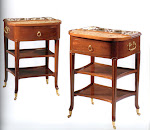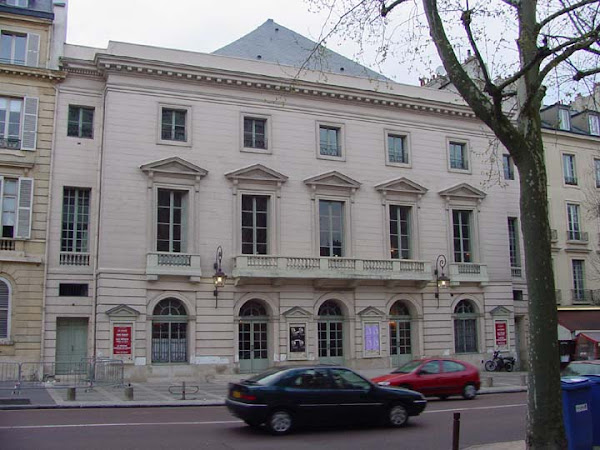What is not widely known, is that the sculptor had to return to his atelier and his responsibilities in Paris in the last years of the Ancien Regime in December of 1785. As a result, he needed a stand in model to pose for the body of the general. Fortunately, one of the undeservedly lesser known and appropriately statuesque figures from among the ranks of the American Founding Fathers was around to step up to the platform and model in Houdon's atelier. It was the gregarious and resourceful Gouverneur Morris of New York who had recently arrived in Paris to undertake some affairs on behalf of then recently installed President Washington while attending to some of his own private business affairs in the French Capital on the eve of the tumultuous events of 1789.
A peg legged bon vivant with, what contemporary accounts suggest, bags of charm, Gouverneur Morris came from the ranks of the real inner circle of colonial aristocracy of British New York. Losing a leg by amputation as the result of an accident during which he was courting a fetching young lady while driving a phaeton in 1780, didn't seem to put a damper on his joie de vivre or cramp his style. And style was also something on which this gentleman who enjoyed life and the company of pretty women was never short. This is an engraved profile portrait of Morris made during his year living in France.
According to James Madison, it was to Gouverneur Morris, who was an important participant in the Constitutional Convention in Philadelphia in 1787, that the finished document owed much of it's polish and clarity of language. Among his additional merits, Morris was a truly talented journalist and chronicler. His diaries, kept during the period he was living in Paris, are seamless and succinct, witty and insightful about men and manners of the upper echelons of Parisian and Court Society during the closing years of the ill fated reign of Louis XVI for whom it's evident that Morris entertained a degree of sympathy.
This is a plaster portrait bust of Gouverneur Morris by the hand of the great master sculptor of the period with whom we became acquainted above, Jean-Anotine Houdon.
Arriving in Paris in early 1789, he inevitably called on Thomas Jefferson who was the official American Envoy at the time and who had taken up residence at the elegant Hôtel Langeac, where Morris notes in his diaries, "Mr Jefferson keeps a good table". Jefferson's portrait by John Trumbull made at the time is seen below.
In his lively diaries, Morris notes one evening on the eve of the convocation of the Estates General, he accompanied Jefferson to the most influential political salon of the day hosted by Madame Necker seen below. Morris did not seem to be as impressed as so many of his contemporaries, by Madame Necker's reputed beauty and gifts of communication and ability to charm people. In his diaries he likened her to a laundress!
Madame Necker was an inspired promoter of the career of her husband, Jacques Necker who had recently been recalled by Louis XVI to power to bring order to the chaos of the Crown's finanances. By background a Calvanist from Geneva, Necker had enjoyed a long and financially rewarding career as a banker and was believed would deliver the kingdom from financial ruin and restore order when resuming his position of Minister of Finance to which he'd recently been reappointed in 1788. This is an engraved portrait of Jacques Necker below. In the same diary entry in which Morris records his evening at the Salon Necker with Jefferson, he notes that upon making his entrance at the gathering, Messr. Necker had the air of someone who was aware that he was "THE MAN" of the times...
Although he makes no particular mention of it in his diary entry about the evening, Morris's subsequent and discerning purchases of some of the finest late 18th Century Parisian ébénisterie and menuiserie that first arrived in the fledgling United States, would suggest wherever he went as his social and business peregrinations led him from one aristocratic Hôtel Particulier to another he did not neglect to observe the decor and quality of the appointments which were to gain his admiration and certainly influence his taste. Below is the salon of Jacques and Suzanne Necker's Chateau de Coppet in their native Switzerland in Geneva. It is clearly furnished with fine Louis XVI furniture which can be safely understood to have been ordered by the Neckers when living in Paris in the 1770''s and 1780's and which followed them to Chateau de Coppet when Necker resigned and retired to Geneva in 1790 in the wake of his unsuccessful efforts to save both the French treasury and the King.
Reading the diaries it becomes apparent that Morris was - and enjoyed being - something of a social butterfly. And it's no less clear he enjoyed calling on many of the widely admired aristocratic beauties of Parisian society of the last years of the Ancièn Regime. Among them was the languid and undeniably well pedigreed beauty seen below, Louis Marie Adélaïde de Bourbon, Duchesse d'Orleans, as painted by Vigée Lebrun. Of course, she was the unfortunate wife of the difficult and revolutionary trouble maker, Philippe, Duc d'Orleans who eventually became the dreaded Philippe Egalité.
In his dairies. Morris often sights his admiration for the duchess and her restrained composed behavior, when he calls on her at the Palais Royale, as she quietly endures her husband's flagrant infidelities and brazen continued intrigues aimed at undermining the position of their mutual cousin, Louis XVI by the Duc's open involvement in various revolutionary elements which he'd clearly hoped might allow him to be offered the crown and allow him to replace the king.
However, the lady who made the most profound impression on Morris was the vivacious and irresistible, Adélaïde-Emilie Filleul, Comtesse de Flahaut. Alas! All I could procure in the way of a portrait likeness of the comtesse is this monochrome photo of a ravishing portrait from a monograph on the artist, Adélaïde Labille Guiard who painted it. The portrait of the comtesse with her infant son (believed to have been fathered by Talleyrand and who later grew up to become the lover of Hortense de Beauharnais!) is seen below.
Jefferson departed Paris in October 1789 to put some personal affairs in order. But upon his arrival in the United Sates, the recently installed President Washington offered him the position of Secretary of State which he accepted. However, it wasn't until 12 January 1792, that Morris was officially named Jefferson's replacement as American envoy. Prior to that, Morris did serve the American president who unofficially appointed him to act for the him concerning resolving issues dealing with the American war debt to France. Morris was to serve out his new appointment from January 1792 until after the fall of the monarchy and remained in Paris in his official capacity until October of 1794 when the majority of envoys representing other kingdoms and European states had left due to the violence unleashed by the Reign of Terror. In a fascinating article by Louis Schreider III entitled Gouverneur Morris: Connoisseur of French Art, published in Apollo Magazine in June of 1971, we learn that Morris did not return directly home to the United Sates. Instead, he traveled in various German speaking cities. It wasn't until 1801 that he returned to his country seat Morrisania.
While living in Paris, Gouveneur Morris, nothing less than an astute observer of society's ways, also seems to have developed an appreciation for the unparalleled elegance of the surroundings that were the backdrop of both the salons and the boudoirs he endlessly frequented. The Swedish artist active in the Paris of Louis XVI, Lavrience has left us ravishing visual documentation of the life of the Parisian salons that Morris would have frequented. Two depicting gatherings at the Paris residence of the Duc de Luynes are seen below.
Lavrience has also recorded the sort of setting in which a contemporary would have enjoyed a morning cup of coffee or chocolate. It is not unlikely Morris's own mornings at his Parisian residence located on the Rue de la Planche, transpired in a similar milieu and surrounding.
Diaries also record visits to Réveillon, the premier manufacturer of papier peint. Lamentably, as the papier peints were intended for the Parisan residence, it's unknown what patterns were acquired for the Rue de la Planche house. But samples of what Réveillon produced at the time are well known and some are seen below. However, although Morris does refer to visits to Réveillon's factory, in truth, that establishment had been taken over by Jacquemart et Bérnard by mid 1791. The latter continued to produce the same patterns of the manufacturer who it had acquired.
At a recent auction at Sotheby's, New York, a Lépine mantle clock that once belonged to Gouverneur Morris was sold during a sale of the collections of the late Mrs. Robert Lehman on 18 November 2010 (Lot 128). In inevitable Neoclassical style from the early 1790's, it is of patinated bronze, with ormolu and white marble. It is plausibly the one cited in the diary entry of October of 1792 in which Morris informs us he paid the clock maker 2400 livres for "deux pendules avec ses vases pour accompagner la plus grande". It is seen below.
This tall case regulateur clock with works by Lépine (or possibly his assistant Claude Raguet from what is implied by a remaining signed paper label in the clock) and a sumptuous mahogany case by the ébéniste Nicholas Petit, is unquestionably the most important time piece Morris acquired while living on the Rue de la Planche from this first rate clock maker who justifiably enjoyed royal patronage. It is seen below.
Its upward tapering shape, reminiscent of an antique obelisk, is surmounted by a patinated bronze bust of a Roman senator. The elegantly decorated enamel circular dial plate is appropriately numbered with Roman Numerals and by the most celebrated enameler of the reign of Louis XVI, Joseph Coteau. The clock was sold by Morris family descendants, along with other items that Morris acquired in Paris during his stay, at a notable auction at Christie's in New York on 22 November 1983.
Among other items offered at this same auction and with which Morris appointed his house on the Rue de la Planche were the two items seen below. One was a seigniorial bureau`a cylindre of mahogany with gleaming ormolu mounts in the manner of Jean-Henri Reisener. It's not too far fetched to envision Gouverneur Morris at this desk writing away, while engaged in endless and demanding diplomatic business and other similar machinations involving a brief ill fated attempt to rescue the royal family for whom he clearly felt sympathy in spite of the fact his official position demanded complete impartiality to the internal political situation in France. It is known that Morris even accepted money for safe keeping from Louis XVI and which years later the envoy duly and honourably saw to it was place in the hands of the sole surviving daughter Madame Royale, when Morris had occasion to return it to her in Vienna where she had take refuge with her Hapsburg relations after miraculously being allowed to leave Revolutionary France in exchange for French Prisoners in Austria.
Another fine example of late Louis XVI period furniture the American envoy acquired for his house and that later followed him to the United States, was this handsome mahogany and ormolu semainier chest of drawers, made ca 1790 and possibly by the atelier of Jean-Henri Reisener. It is surmounted by a fine white marble top of which the rectangular corners have chamfered corners echoing the chamfered sides along the front of the semainier. The applied ormolu borders having a delicately cast egg and dart motif with the ring handles decorated with laurel leaves are of a finesse that one does associate with the productions of the most accomplished ciseleur doreurs of the Paris of Louis XVI and Marie Antoinette.
However it is at the Revolutionary Period sales of former French Royal furniture, where Gouverneur Morris availed himself of a unique opportunity to purchase some of the finest furniture of his time and that would not be out of place in the finest palaces of Europe. Below is a published notice of the sales are Morris would have undoubtedly also seen and read.
The most significant purchase made from these sale was indisputably a suite of seating furniture by the menuisier François II Foliot. The decorative carving was by the artisan Babel, the gilding was done in the atelier of Marie-Catherien Renon, and the suite was executed by designs by Gondoin.
The suite once, briefly furnished the drawing room of Queen Marie Antoinette in her private suite of apartments at The Chateau de Versailles. Below is a portrait of the ill fated queen for whom Morris retained a great sympathy and a view of the same room from which the suite originally came. The portrait was by the Polish portrait painter patronized extensively by the Queen during the revolutionary period, Kucharsky. It shows a more sober and introspective Marie Antoinette and represents how Morris would have seen her. The current appearance of the room is closer to how the drawing room appeared when it was redecorate later in 1783 for the queen and this suite Morris acquired was relegated to the apartments of Mesdames Tantes, the spinster aunts of Louis XVI.
Below are more views with details...
Many of the items that made up the purchases Morris made at the various establishments of ateliers, marchands merciers and later at the Revolutionary sales I have illustrated herein, were among various items acquired by Morris in Paris that his family descendants sold at that same aforementioned 1983 Christie's auction. One more intriguing example of superb menuiserie of possible Royal Provenance about which more investigation is merited is the purchase of a pair of canapés offered at that 1983 auction as Lot 217. It was presented to potential bidders and sold as a pair stamped by the Queen's preferred menuisier, the widely admired Georges Jacob. One of the pair, as illustrated in the catalog is seen below.
As per the Catalog description, this pair, having similar but not identical carved decoration to the prior discussed suite, also "has affixed to its back seat rail the handwritten label inscribed Monsieur Bonnefoy" which made plausible the thesis the pair was ordered on behalf of the queen by her personal man charged with ordering her furniture for Petit Trianon, Bonnefoy-Duplan. His actual title was Garçon Concierge du Guarde Meuble `a Versailles et au Petit Trianon. At the time, the catalog is unable to state with certainty the pair was part of the furniture at Petit Trianon. But what is certain is that the quality of carving and gilding is not inferior to that expected to meet the queen's demanding standards.
A probably very weary Gouverneur Morris returned to The United States and Morrisania after his return to America shortly after his former Paris colleague Thomas Jefferson had won the Presidential election of of 1800. His portrait by Sharples was made after his return from his long European travels and is seen below.
After years of wandering the Continent and endless involvements with beautiful and witty women, Morris, at the age of 57 eventually settled down and married the 35 year old Anne Cary Randolph who was the daughter of Ann Cary and Thomas Mann Randolph Sr and the sister of Thomas Mann Randoph Jr who was, in turn the husband of Thomas Jefferson's daughter Martha! It is probably due to this family marital connexion that a suite of Mahogany fauteuils `a la reine , of which some bear the stamp of Georges Jacob, that also seem to have been acquired by Gouverneur Morris while in Paris, ended up being sold or given to Jefferson and were part of the furniture in the Parlour at Monticello where they can still be seen today.
Of an assertively (if not aggressively!) Neoclassical style often known as Le Gôut Etrusque, these intriguing mahogany armchairs with their clean lines and sweeping saber legs, had been long assumed to be part of the furniture that Jefferson bought from 1784 to 1789 when he lived in Paris and had represented the most advanced taste of the late 1780's as was seldom seen, except in such places as the studio and the paintings of Jacques Louis David for whom, it is documented Jacob provided the artist to use as props that appear in such paintings as his The Lictors Bringing to Brutus and His Family the Bodies of His Dead Sons (dating from 1789) that is seen below. This style, which represented the early stages of Les Styles Directoire and Consulat, aimed to recreate what was then perceived as a more archeological recreation of the furniture used in the world of Ancient Rome.
While Thomas Jefferson was followed by a shipment of a fine representation of Louis XVI furniture, clocks, porcelain, glass, lighting, mirrors, scientific instruments, wallpaper, and endless other items that filled his Paris residence and most of which ended up at Monticello, it was Morris and James Swan (subject for another blog!) who were the first to bring French furniture of the Louis XVI period of truly royal quality and provenance to the United States. And for their efforts, posterity, which is fortunate to visit American museums where these acquisitions can be seen, has much reason to be grateful!
































































